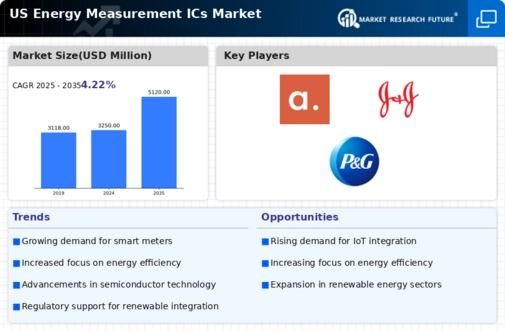Growing Focus on Energy Efficiency
The increasing emphasis on energy efficiency is a significant driver for the energy measurement-ics market. As organizations and consumers alike seek to reduce energy consumption and lower costs, the demand for precise measurement tools has surged. Energy efficiency initiatives, often supported by government incentives, encourage the adoption of advanced measurement technologies. For example, the U.S. government has implemented various programs aimed at promoting energy-efficient practices, which in turn boosts the energy measurement-ics market. This focus on efficiency not only helps in reducing operational costs but also contributes to sustainability goals, making it a dual benefit for stakeholders. The market is likely to continue expanding as more entities recognize the value of accurate energy measurement in achieving efficiency targets.
Regulatory Compliance and Standards
The energy measurement-ics market is increasingly influenced by stringent regulatory frameworks and standards set by government bodies. Compliance with these regulations is essential for companies operating in this sector, as non-compliance can lead to significant penalties. For instance, the U.S. Department of Energy has established guidelines that mandate accurate energy measurement for various applications. This regulatory environment drives demand for advanced measurement technologies that ensure compliance, thereby fostering growth in the energy measurement-ics market. Furthermore, adherence to these standards often necessitates investment in new technologies, which can lead to increased market activity and innovation. As regulations evolve, companies must adapt their measurement solutions to meet new requirements, indicating a dynamic interplay between regulation and market development.
Rising Energy Costs and Economic Pressures
Fluctuating energy prices and economic pressures are compelling businesses and consumers to seek better energy management solutions. The energy measurement-ics market is experiencing heightened demand as organizations strive to monitor and control their energy expenditures more effectively. With energy costs rising, companies are increasingly investing in measurement technologies that provide insights into consumption patterns and identify areas for cost savings. This trend is particularly evident in sectors such as manufacturing and commercial real estate, where energy costs can significantly impact the bottom line. As economic conditions evolve, the need for effective energy management solutions is likely to drive further growth in the energy measurement-ics market, as stakeholders look for ways to mitigate financial risks associated with energy consumption.
Increased Adoption of Renewable Energy Sources
The transition towards renewable energy sources is reshaping the energy measurement-ics market. As more organizations integrate solar, wind, and other renewable technologies into their energy portfolios, the need for accurate measurement and monitoring becomes paramount. This shift necessitates advanced measurement solutions that can handle the complexities associated with variable energy generation. The market is poised for growth as companies seek to optimize the performance of their renewable energy systems. Furthermore, government incentives and policies promoting renewable energy adoption are likely to bolster this trend, creating a favorable environment for investment in measurement technologies. As the landscape of energy generation evolves, the demand for precise measurement tools will continue to rise, indicating a robust future for the energy measurement-ics market.
Technological Advancements in Measurement Devices
Technological innovation plays a pivotal role in shaping the energy measurement-ics market. The advent of sophisticated measurement devices, such as smart meters and IoT-enabled sensors, has revolutionized how energy consumption is monitored and managed. These devices provide real-time data, enhancing operational efficiency and enabling better decision-making. According to recent data, the market for smart meters alone is projected to reach approximately $10 billion by 2026, reflecting a compound annual growth rate (CAGR) of around 8%. This surge in demand for advanced measurement technologies indicates a broader trend towards automation and data analytics in the energy sector. Consequently, companies that invest in cutting-edge measurement solutions are likely to gain a competitive edge in the energy measurement-ics market.













Leave a Comment